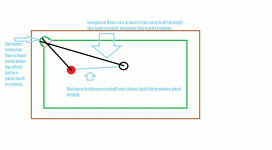A few years ago I was working on an aiming system of my own design (as far as I know this is my own design, I may have been inspired by something I've seen, but I don't think so). I don't have the numbers anymore, as they were in a notebook I can no longer find. I discarded the system as not practical and flawed, but maybe you guys will find it interesting nevertheless. There are some problems with it, I wonder if you guys will realize what they are? The idea was that the system could be objective (at least on a particular brand of table). I certainly do not claim it as such today.
The idea was that the system could be objective (at least on a particular brand of table). I certainly do not claim it as such today.
The system itself is a pivot system, with a built in measurement to determine tip offset.
The idea is quite simple. You start by determining the distance between the cueball and the object ball. That will determine the length of your bridge. The closer the two balls are, the shorter the bridge becomes. Which means the system becomes less useful for very close shots (as the pivot length approaches zero). I used diamonds as the unit for my measurement.
You then draw imaginary lines from the center of each ball through a point in the exact center between the two cushion points, extending through that point and to the back pocket. If the balls are not aligned straight in, the two lines will be some distance apart in the back of the pocket. That distance will determine your starting tip offset, pre pivot.
My original system had only one starting alignment: Center to center.
So with a certain shot, maybe a 12 inch bridge would be indicated by the distance between the balls. The distance between the lines in the back pocket might indicate a starting tip offset (with cue paralell to center to center line) of 1.5 tips. From that starting alignment you would then pivot back to cueball center and shoot. The pivot would be a strict pivot around the bridge (as the pivot point). Please excuse the crudeness of the illustration. I cannot draw, and only had "paint" to boot!
What do you guys think?
The system itself is a pivot system, with a built in measurement to determine tip offset.
The idea is quite simple. You start by determining the distance between the cueball and the object ball. That will determine the length of your bridge. The closer the two balls are, the shorter the bridge becomes. Which means the system becomes less useful for very close shots (as the pivot length approaches zero). I used diamonds as the unit for my measurement.
You then draw imaginary lines from the center of each ball through a point in the exact center between the two cushion points, extending through that point and to the back pocket. If the balls are not aligned straight in, the two lines will be some distance apart in the back of the pocket. That distance will determine your starting tip offset, pre pivot.
My original system had only one starting alignment: Center to center.
So with a certain shot, maybe a 12 inch bridge would be indicated by the distance between the balls. The distance between the lines in the back pocket might indicate a starting tip offset (with cue paralell to center to center line) of 1.5 tips. From that starting alignment you would then pivot back to cueball center and shoot. The pivot would be a strict pivot around the bridge (as the pivot point). Please excuse the crudeness of the illustration. I cannot draw, and only had "paint" to boot!
What do you guys think?
Attachments
Last edited:
